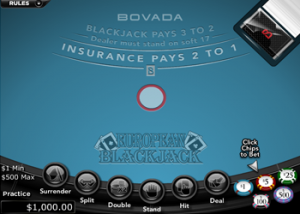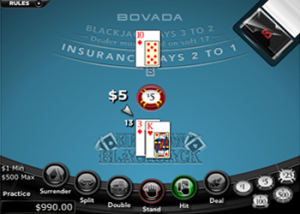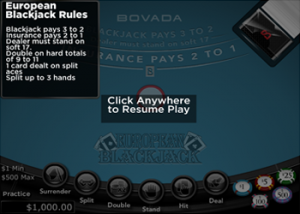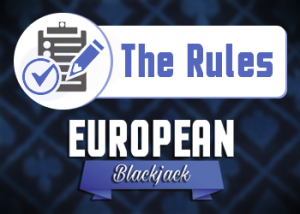European Blackjack
 Generally speaking, Europeans simply know how to gamble better than Americans, at least that’s true with the games that originated in Europe. The Roulette wheels only have one zero, (no, more zeroes does NOT mean, ‘More ways to win!) and sometimes, that zero does not even necessarily mean that player loses his/her entire bet! There are some games that are played better in the Red, White & Blue, though, Video Poker being a good example. Another example is Blackjack in which the dealer peeks for Blackjack when he/she is showing a ten or an ace.
Generally speaking, Europeans simply know how to gamble better than Americans, at least that’s true with the games that originated in Europe. The Roulette wheels only have one zero, (no, more zeroes does NOT mean, ‘More ways to win!) and sometimes, that zero does not even necessarily mean that player loses his/her entire bet! There are some games that are played better in the Red, White & Blue, though, Video Poker being a good example. Another example is Blackjack in which the dealer peeks for Blackjack when he/she is showing a ten or an ace.
The main difference between a game of, ‘European,’ Blackjack (also known as, ‘No Peek’) and American Blackjack is the fact that the dealer checks a hole card for a natural when the dealer is showing a ten or an ace. This is quite a beneficial rule for the player because the player does not continue to act (i.e. put more money out) if the player has no chance against beating the dealer. In an American game, the player should double a total of eleven against a dealer Ten or Ace if the player knows the dealer does not have blackjack, but in a European game, the player has no such knowledge.
Another disadvantage in European Blackjack, as opposed to American, is that the knowledge that a dealer does not have a natural will otherwise enable a player to play some hands by making decisions to either hit or stand. Many of these hands should be surrendered if the player is unaware of whether or not the dealer has a natural.
 There are two different ways of playing European Blackjack with one in which a dealer will only take a player’s original wager in the event that the dealer has a natural, and in the other way, the dealer will take all amounts the player has wagered (including wagers made on splits/doubles). It is for that reason, in a game of four or more decks, that a player playing a game in which the dealer takes all wagers with a Natural, the player will never double against a dealer Ace/Ten and will only split Aces against a dealer ten, but not against a dealer Ace.
There are two different ways of playing European Blackjack with one in which a dealer will only take a player’s original wager in the event that the dealer has a natural, and in the other way, the dealer will take all amounts the player has wagered (including wagers made on splits/doubles). It is for that reason, in a game of four or more decks, that a player playing a game in which the dealer takes all wagers with a Natural, the player will never double against a dealer Ace/Ten and will only split Aces against a dealer ten, but not against a dealer Ace.
That does not make the game in which the player loses his original wager only the same as American Blackjack, because there are still hands to consider that would have a player surrender against a dealer Ace/Ten in situations that a player would not surrender in American Blackjack. Although, if the player is not allowed to surrender AND the  dealer only takes the original wager, the two games are essentially the same…the European one would just pointlessly take longer!
dealer only takes the original wager, the two games are essentially the same…the European one would just pointlessly take longer!
As we have discussed before, the number of decks with which a Blackjack game is played is essentially a rule unto itself and impacts the House Edge of the game accordingly. In the event that all other rules are equal, then the more decks a Blackjack game has, the greater the House Edge will be against the player, which is to say that there will be a lesser return to player. This remains true of European Blackjack as well as American Blackjack.
In order to understand the effects of other rules on a European Blackjack game, we must first develop a, ‘Control game,’ against which we can compare certain rule  changes.
changes.
- Decks: 8
- Soft 17: Dealer Hits
- Double After Split: Yes
- Double On: ANY
- Player Can Resplit: Twice to Four Total Hands
- Resplit Aces: No
- Hit Split Aces: No
- Dealer Peeks: NO, Player Loses All Bets
- Surrender: NO
- Blackjack Pays: 3:2
Number of Decks:
With our, ‘Control Game,’ the House Edge with Basic Strategy is 0.77210%, if we compare that to single-deck with the exact same set of rules, the single deck game would have a House Edge of 0.27270% for a difference of 0.49940% added to the House Edge for the eight-deck game.
This is not only because of fundamental hands/decisions being more powerful for a player in a single-deck game due to the effect-of-removal (cards coming out of the deck) but also because there are some plays that get made as a result of effect-of-removal in a single deck game that does not happen in an eight-deck game. For one thing, given the effect-of-removal, the player will double soft hands against a dealer more frequently, in general, than with the eight-deck game.
The effects of fewer decks become less pronounced as we get closer to eight decks, let’s take a look at how the number of decks changes the House Edge with the rules of our control game otherwise being the same:
- Eight Decks: 0.7721%
- Six Decks: 0.75015%
- Five Decks: 0.73575%
- Four Decks: 0.70838%
- Two Decks: 0.56931%
- One Deck: 0.2727%
Again, while, ‘The fewer decks, the better,’ is sufficient as a general rule, it is important to look at the entirety of the Rules when comparing one Blackjack game to another to determine which has the lower house edge and is more favorable to the player:
The Rules:
 The base European eight-deck game of Blackjack does not give the player an opportunity to play deck composition strategy right off the top, and honestly, would not generally be considered terribly vulnerable to card counting depending on the other rules involved. That’s not to say that such a game could not be counted, to wit, virtually any game (except continuous shuffle) theoretically, could be counted, it’s just that players would tend to look for a more favorable game than this eight-deck no-peek game.
The base European eight-deck game of Blackjack does not give the player an opportunity to play deck composition strategy right off the top, and honestly, would not generally be considered terribly vulnerable to card counting depending on the other rules involved. That’s not to say that such a game could not be counted, to wit, virtually any game (except continuous shuffle) theoretically, could be counted, it’s just that players would tend to look for a more favorable game than this eight-deck no-peek game.
The first rule change we will examine is whether or not a dealer hits or stands on soft-17, which is any hand that adds up to seventeen with the Ace counting as eleven. In other words, A-6 would be an example of a Soft-17, A-2-4 is another example and A-2-2-2 is yet another. These types of hands actually come up slightly more frequently in an eight-deck game than a single deck game because removing a low card (the cards needed to result in a soft hand, eventually) does not leave as few low cards (as a percentage) relative to the remainder of the cards in an eight-deck game.
The rules for our control game assume that the Dealer Hits on a total of soft-17 whereas it would be better for the player if the dealer stood. While it may seem strange that it benefits the player for the dealer to continue to hit to what would otherwise be a low final hand of seventeen, it is important to remember that the player has already acted and that hitting a Soft-17 gives the dealer several opportunities to improve the hand with a nearly equal number of opportunities to keep it the same as if the dealer had stood.
If there is any question as to that, consider this: Basic Strategy dictates that a player with Soft-17 literally never stands regardless of the dealer’s up-card. If standing against the dealer with a Soft-17 is never a good decision for the player, then it stands to reason that the same decision would not benefit the dealer, either.
There’s no need to believe me, though, you could simply look at our strategy engine
And you will see that, with Basic Strategy, based on our control game, when we switch it to force the dealer to stand on Soft-17, the house edge is reduced to 0.55853%, which is a difference of 0.21357% in favor of the player. Definitely helpful to lock in that seventeen for the dealer, isn’t it?
The next rule that we must take a look at is the doubling rule, some casinos will allow a player to double on any two cards the player likes, whereas stingier casinos only allow doubling on certain hand totals which may either be nine through eleven, and sometimes, only hand totals of ten or eleven.
For example, a player would double a soft 15-18 against a dealer four, but none of those would represent a value that could be doubled in a game that only allows doubling on 9-11 or 10-11. There are other examples still, so this rule is not a negative only because the player would only be allowed to double on those hard hand totals, (the player only doubles a hard eight in single deck games with these rules) but mostly because it prevents the player from doubling on several soft hands.
Our control game allows for doubling on Any Two cards, but if the player could only double on 9-11 and keep all other rules the same, (eliminating all soft doubles except one, soft-19 against dealer six) the house edge increases to 0.87607%, which is a difference of 0.10397% compared to being able to double on anything.
In addition to eliminating all soft double situations, the situation of doubling a hard nine against a dealer showing a 2-6 would also be eliminated if the player could only double on 10-11. If that were to happen, the House Edge would be 0.96840% which is 0.19630% more than in our control game in which the player can double on anything.
Let’s now look at splitting and doubling after the split, if allowed.
The first question is to how many hands may a player split? For example, if the player is dealt a 8-8 (Hard 16) against any dealer card, (except an Ace or Ten, which the player should Surrender, if allowed, and hit, if not) then the player is supposed to split the eights and take a new card on each of the two eights in order to form two new hands. In some Blackjack games, the player has the opportunity to do this yet again if the player were to draw another eight on one of the other hands, and then even again after that, if applicable! This process is called, ‘Re-Splitting,’ and the ability to do so is a very favorable rule for the player and also adds to the fun of the game. There are a few Blackjack games that allow unlimited re-splits, but it is extremely rare to ever resplit more than twice.
Our control game assumes a player can resplit (twice) to a total of four hands and the difference in being able to split to a total of three hand only (i.e. resplit once) rather than all four is 0.00856% added to the house edge whereas the difference in not being able resplit at all compared to resplitting to four total hands is 0.05300% added to the house edge. These differences aren’t quite as large when playing with fewer decks simply because it is less likely that the player will draw repeating cards to begin with as a result of effect-of-removal.
The next question relevant to the player is whether or not the player is permitted to double-after-splitting, which essentially gives the player the ability to take a hand that started off as garbage and turn it into a powerful (read: positive expectation) hand that should be doubled! One example of a hand in which a player would want to be able to do so is a hand such as 4-4 against a Dealer six which is split and the player draws either a five, six or seven, (depending on what the rules are for what a player can double on) that is definitely a situation in which the player would want to be able to double after splitting.
If the player does not have the ability to double after splitting, then the House Edge is increased by about 0.14245% to 0.91455% as compared to our control game. This difference becomes slightly less if the player could not split to multiple hands because fewer hands mean fewer potential opportunities to double after splitting.
Blackjack rules typically dictate that a player can only Split Aces once, and so do the rules of our control game. Resplitting Aces is advantageous for the player because once split, aces can often not be hit upon or resplit, which means if you split two aces and draw an A to one of the split Aces, then you are stuck with a lousy hand total of hard-12. If the dealer does anything but bust, you lose.
If our control game did allow for the resplitting of Aces, then the house edge would be reduced to 0.70768% which is a difference of 0.06442% off of the house edge of our control game.
The next rule we’ll look at is whether or not a player can hit on Aces that have already been split. We are going to go back to assuming that the player may not resplit the aces because the player may not do so in our control game. The ability to hit Aces that have been split is an incredibly positive allowance for the player because it enables the player to take advantage of splitting Aces without worrying about any chance of being stuck on a bad (12-16) hand that cannot win unless the dealer busts. Sometimes the player would want to hit such a hand total if the dealer is not showing a bad card, but against something like a dealer six, of course, the player would still stand the bad hand total even if the player could hit.
However, splitting Aces against something like a dealer ten would be a good play, and it would be even better if the player could hit any soft hand lower than a nineteen total.
Essentially, what happens if the player is allowed to hit split Aces is that the player will not be stuck on hand totals of 12-16 after taking the card on each of the split Ace hands. In fact, the worst case scenario, if the player cannot resplit Aces, is that the player ends up drawing another Ace (Hard 12 total) as that is the only, ‘Hard,’ hand the player can end up with, and therefore, the only hand in which a third card (the hit) could potentially bust the player if it is indeed advisable for the player to hit at all. (The player would still not hit against a dealer four, five or six) Otherwise, every card on the split aces will either give the player a completed hand or alternatively, the potential to take a hit to improve the hand with literally zero risk of busting.
Given all of our other rules, the ability to hit Split Aces (no resplitting) improves the game to a house edge of 0.59261% which is an improvement of 0.17949% off the house edge compared to our control game.
The next question is whether or not a player is allowed to Surrender, which means to forfeit his/her hand and receive half of his/her wager back if he/she does not like the hand. The ability to Surrender impacts the House Edge even more greatly in a European, ‘No-Peek,’ game because there are several additional occasions in which a player will Surrender against a dealer showing an Ace or a Ten when the player is not allowed to know if the dealer has a Blackjack ahead of time. The ability of a player to surrender in our control game would decrease the house edge to 0.67387%, which would be a reduction of 0.09823% from the House Edge.
The final rule that we will look at is Blackjack paying 6:5 rather than 3:2. I hope this rule hasn’t spread to European Blackjack yet, if it has, better to give European Roulette with the imprisonment rule a look!
How Do the Rules Affect Me?
When it comes to the effects of the Rules, let’s look at the most player-favorable set of rules for a double-deck game v. the most player unfavorable set of rules. I believe this will help everyone see how much of a difference the rules can make.
Favorable:
- Number of Decks: 1
- Dealer Stands on Soft 17
- Double After Split: Yes
- Double on: Anything
- Resplit: Up to Four Hands
- Resplit Aces: Yes
- Hit Split Aces: Yes
- Dealer Peeks: NO
- Surrender: Yes
- Blackjack Pays: 3:2
With just Basic Strategy (as opposed to Optimal deck-composition strategy) the player advantage on this set of rules would be 0.11158%, which means that the player would be expected to profit about eleven cents for every $100 in action. Let us compare that with the worst possible set of rules:
- Number of Decks: 8
- Dealer Hits Soft 17
- Double After Split: No
- Double: 10-11 Only
- Resplit: No
- Resplit Aces: N/A
- Hit Split Aces: No
- Dealer Peeks: No
- Surrender: No
With all of that, the house edge with Basic Strategy would be 1.1248%, which would mean the player is expected to lose about $1.125 of every $100 bet. The overall difference between these two games is 1.23638%, nearly a buck and a quarter per $100 bet difference. If we make Blackjack pay 6:5 on our bad rules, the House Edge goes up to 2.48278%, and even with our otherwise great rules, the player advantage turns into a house edge of 1.28319%.
Instead of playing 6:5 Blackjack, just stick some dollar bills into a washing machine and watch the water disintegrate them, it will be more entertaining.
Conclusion:
Once again, all other things equal, the European, ‘No Peek,’ rule is not only a bad rule for the player, but it also complicates basic strategy. (Unless it is the first set of rules you learned, then the thought of doubling against a ten or ace might, ‘Complicate,’ basic strategy for you!) Furthermore, the player will find himself/herself surrendering against many additional dealer hands simply because the player cannot rule out a dealer natural as a possibility.
Whether or not the game is worth playing overall simply depends on the rest of the rules for the Blackjack game besides the fact that it is a no hole card game. It is possible for a game to be European, but otherwise, have pretty good rules, and be the best game on either the floor or on the online casino you are visiting. As with anything else, the key is knowing the effect of the totality of the rules rather than just focusing on whether or not a game has any individual rule.
Software Providers that have European Blackjack
| Software | BJ Pays | Soft 17 | Double | Re-Split Aces | Surrender | House Edge | Total Decks |
|---|---|---|---|---|---|---|---|
| Bodog | 3:2 | Stand | 9 to 11 | No | No | 0.66% | 6 |
| BetSoft | 3:2 | Stand | 9 to 11 | No | No | 0.66% | 6 |
| SoftSwiss | 3:2 | Stand | 9 to 11 | No | No | 0.67% | 6 |
| Realtime Gaming | 3:2 | Stand | 9 to 11 | No | No | 0.75% | 6 |
Other Online Blackjack Variations
- 21 Burn
- Blackjack
- Blackjack Atlantic City
- Blackjack Atlantic City Gold
- Blackjack Multi-Hand
- Blackjack Switch
- Double Attack Blackjack
- Double Deck Blackjack
- Dr Fortuno Blackjack
- European Blackjack
- European Blackjack Redeal
- Lucky Blackjack
- Match Play 21
- Mutli-hand Blackjack
- Perfect Pairs Blackjack
- Pirate 21
- Pontoon
- Power Blackjack
- Single Deck Blackjack
- Sonya Blackjack
- Spanish 21
- Suit ‘Em Up Blackjack
- Super 21
- Zappit Blackjack